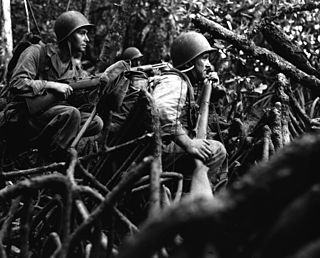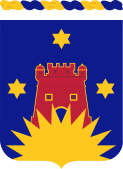
The Guadalcanal campaign, also known as the Battle of Guadalcanal and codenamed Operation Watchtower by American forces, was a military campaign fought between 7 August 1942 and 9 February 1943 on and around the island of Guadalcanal in the Pacific theater of World War II. It was the first major land offensive by Allied forces against the Empire of Japan.

The New Georgia campaign was a series of land and naval battles of the Pacific campaign of World War II between Allied forces and the Empire of Japan. It was part of Operation Cartwheel, the Allied strategy in the South Pacific to isolate the Japanese base around Rabaul. The campaign took place in the New Georgia group of islands, in the central Solomon Islands and followed the Allied capture of the Russell Islands. The main fighting took place on New Georgia island itself, although significant actions also took place around the island chain throughout the campaign.

Major General Merritt Austin Edson, Sr., known as "Red Mike", was a general in the United States Marine Corps. Among the decorations he received were the Medal of Honor, two Navy Crosses, the Silver Star, and two Legions of Merit. He is best known by Marines for the defense of Lunga Ridge during the Guadalcanal Campaign in World War II.

Kenneth Dillon Bailey was a United States Marine Corps officer who posthumously received the Medal of Honor for heroic conduct during action during the Battle of Guadalcanal in the Solomon Islands. He also earned the Silver Star Medal during the initial landing on Tulagi in the Solomon Islands and the Purple Heart.

Captain Carlton Robert Rouh was a United States Marine who received the Medal of Honor for gallantry in risking his life to save the lives of two fellow Marines on Peleliu Island on September 15, 1944. First Lieutenant Rouh threw his body between his fellow Marines and an exploding grenade. During World War II, 27 Marines similarly used their bodies to cover grenades in order to save the lives of others. Four of these Marines survived — including Rouh and fellow Medal of Honor recipients Richard E. Bush, Richard K. Sorenson, and Jacklyn H. Lucas

The Battle of Vella Lavella was fought from 15 August – 6 October 1943 between Japan and the Allied forces from New Zealand and the United States at the end of the New Georgia campaign. Vella Lavella, an island located in the Solomon Islands, had been occupied by Japanese forces early during the war in the Pacific. Following the fighting around Munda Point, the Allies recaptured the island in late 1943, following a decision to bypass a large concentration of Japanese troops on the island of Kolombangara.

Lewis William Walt, also known as Lew Walt, was a United States Marine Corps four-star general who served in World War II, the Korean War, and the Vietnam War. Walt was decorated several times, including two Navy Crosses for extraordinary heroism during World War II, one for leading the attack on "Aogiri Ridge" during the Battle of Cape Gloucester ; the ridge was renamed "Walt's Ridge" in his honor.

The Battle of the Tenaru, sometimes called the Battle of the Ilu River or the Battle of Alligator Creek, was a land battle between the Imperial Japanese Army and Allied ground forces that took place on August 21, 1942 on the island of Guadalcanal during the Pacific campaign of World War II. The battle was the first major Japanese land offensive during the Guadalcanal campaign.

The Battle for Henderson Field, also known as the Battle of Guadalcanal or Battle of Lunga Point by the Japanese, took place from 23 to 26 October 1942 on and around Guadalcanal in the Solomon Islands. The battle was a land, sea, and air battle of the Pacific campaign of World War II and was fought between the Imperial Japanese Army and Navy and Allied forces, mainly U.S. Marines and Army. The battle was the last of three major land offensives conducted by the Japanese during the Guadalcanal campaign.

Mitchell Red Cloud Jr. was a United States Army corporal who was killed in action while serving in the Korean War. Corporal Red Cloud posthumously received the Medal of Honor for heroic actions "above and beyond the call of duty" near Chonghyon, North Korea, on 5 November 1950 during the Chinese First Phase Campaign. Before joining the army, he had been a United States Marine Corps sergeant who had served in World War II.

The Actions along the Matanikau—sometimes referred to as the Second and Third Battles of the Matanikau—were two separate but related engagements, which took place in the months of September and October 1942, among a series of engagements between the United States and Imperial Japanese naval and ground forces around the Matanikau River on Guadalcanal Island in the southwestern Pacific northeast of Australia, during the Guadalcanal campaign. These particular engagements—the first taking place between 23 and 27 September, and the second between 6 and 9 October—were two of the largest and most significant of the Matanikau actions.

The 164th Regiment is a training unit of the North Dakota Army National Guard. As the 164th Infantry Regiment, it was formed in the 1920s but traced its history to North Dakota units formed in the 1900s. The regiment was the first United States Army unit to land on Guadalcanal during World War II
Charles L. McGaha was a United States Army soldier and a recipient of the United States military's highest decoration—the Medal of Honor—for his actions in World War II.

The Battle of Mount Austen, the Galloping Horse, and the Sea Horse, part of which is sometimes called the Battle of the Gifu, took place from 15 December 1942 to 23 January 1943 and was primarily an engagement between United States and Imperial Japanese forces in the hills near the Matanikau River area on Guadalcanal during the Guadalcanal Campaign. The U.S. forces were under the overall command of Alexander Patch and the Japanese forces were under the overall command of Harukichi Hyakutake.

The Battle of Munda Point was a battle, from 22 July – 5 August 1943, between primarily United States Army and Imperial Japanese Army forces during the New Georgia Campaign in the Solomon Islands in the Pacific War. The battle took place following a landing by U.S. troops on the western coast of New Georgia from Rendova, as part of an effort to capture the Japanese airfield that had been constructed at Munda Point. This advance had become bogged down and while the Allies brought forward reinforcements and supplies, the Japanese had launched a counterattack on 17–18 July. This effort was ultimately unsuccessful and afterwards U.S. forces launched a corps-level assault to reinvigorate their effort to capture the airfield. Against this drive, Japanese defenders from three infantry regiments offered stubborn resistance, but were ultimately forced to withdraw, allowing U.S. forces to capture the airfield on 5 August. The airfield later played an important role in supporting the Allied campaign on Bougainville in late 1943.

World War II in HD is a History Channel television series that chronicles the hardships of World War II, using rare films shot in color never seen on television before. The episodes premiered on five consecutive days in mid-November 2009, with two episodes per day. The series is narrated by Gary Sinise and was produced by Lou Reda Productions in Easton, Pennsylvania, United States.
The 35th Battalion was an infantry battalion of the New Zealand Military Forces, which served in the Pacific theatre of the Second World War from 1941 to 1944. Attached to the 14th Brigade, the battalion was formed in late 1941 and saw service in the Pacific against the Japanese as part of the New Zealand 3rd Division. It initially performed garrison duties on Fiji and New Caledonia before being committed to the fighting in the Solomon Islands in 1943. Returned to New Zealand in late 1944, the battalion was disbanded in early 1945 during a partial demobilisation of New Zealand forces. Many of its personnel returned to civilian employment while others were sent to Italy as reinforcements for the New Zealand 2nd Division. The battalion was awarded four battle honours for its various engagements during the war.

Victor Maghakian, also known as Captain Victor "Transport" Maghakian, was an Armenian American member of the United States Marine Corps during World War II. Having received over two dozen medals and awards, he is considered one of the most decorated American soldiers of the war.
The 30th Battalion was an infantry battalion of the New Zealand 3rd Division, raised for service during the Second World War. After being raised in late 1940, the battalion undertook garrison duties in Fiji and on New Caledonia during the early part of the war, before undertaking combat operations during the latter part of the Solomon Islands campaign, landing on Vella Lavella and the Green Islands in 1943–1944. The battalion was disbanded in mid-1944 to return manpower to the New Zealand economy and to provide reinforcements to the New Zealand 2nd Division, which was fighting in Italy.
John Howard Yancey was a highly decorated United States Marine Corps combat veteran of World War II and the Korean War. He received two Navy Crosses, a Silver Star, a Bronze Star and three Purple Hearts. He is buried at the Little Rock National Cemetery.















